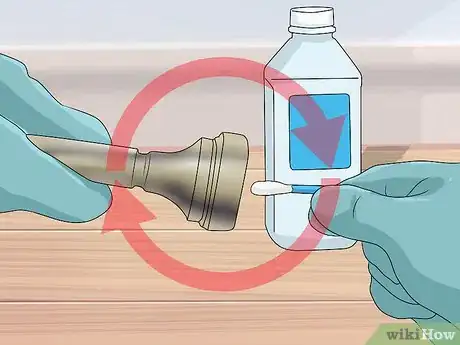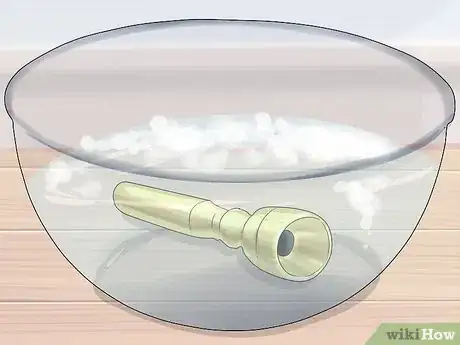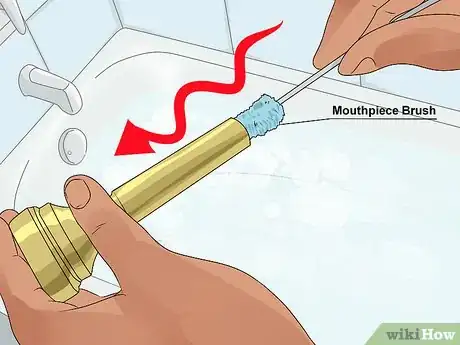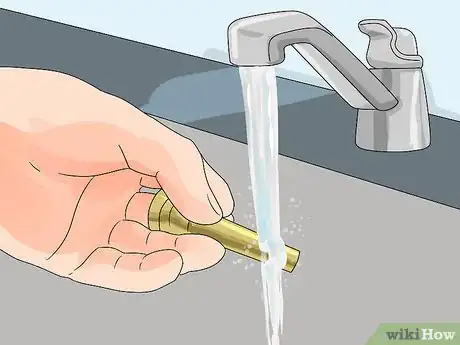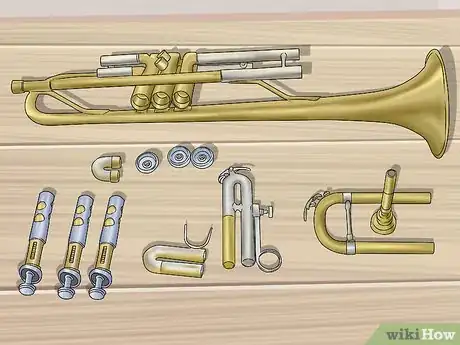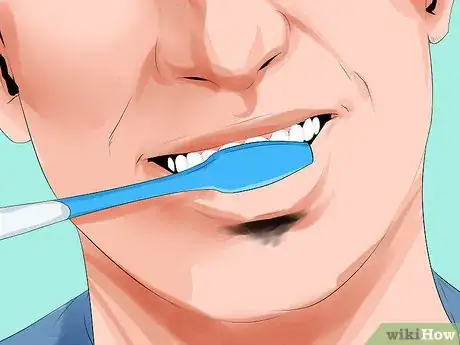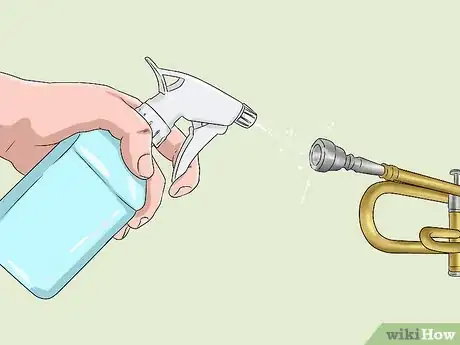This article was co-authored by wikiHow Staff. Our trained team of editors and researchers validate articles for accuracy and comprehensiveness. wikiHow's Content Management Team carefully monitors the work from our editorial staff to ensure that each article is backed by trusted research and meets our high quality standards.
This article has been viewed 29,259 times.
Learn more...
Cleaning your brass instrument can be an enjoyable and healthy activity. Brass instruments tend to accumulate food particles, bacteria, fungi, mold and other grime. For health reasons, it is important to remove the bacteria and other grime.[1] To keep your brass instrument clean, it is best to take a proactive approach and maintain a regular cleaning schedule. It is important to clean both the mouthpiece and the body on a regular basis.[2]
Steps
Cleaning the Mouthpiece
-
1Swab the mouthpiece with isopropyl alcohol. On a daily basis or after each use of the instrument, you should swab the mouthpiece with isopropyl alcohol. Put some of isopropyl alcohol on a cotton swab and wipe off the mouthpiece.
-
2Clean the mouthpiece on a regular basis. The mouthpiece is the part of the instrument that tends to attract the most bacteria, so it needs to be cleaned in a very thorough manner.
- If you play regularly, you should clean the mouthpiece on a daily basis.[3]
Advertisement -
3
-
4Get the inside clean with a mouthpiece brush. Apply soapy water to the mouthpiece brush. Then, insert the brush into the mouthpiece and scrub away all of the bacteria.[6]
-
5Rinse the mouthpiece. Fill a small container with clean water. Put the mouthpiece in the water to rinse off any soap.[7]
- If you prefer, you could also rinse your mouthpiece under the tap.
-
6Sanitize the mouthpiece with sterisol germicide solution. Spray the germicide solution on the mouthpiece. Then, let it dry on a piece of paper towel for one minute. You can dry off the mouthpiece with a paper towel.[8]
Cleaning the Instrument
-
1Disassemble the instrument. Remove the slides, pistons and any other parts.
- Be careful not to lose any pieces.
-
2Give the instrument a rinse once per month. Fill a container with lukewarm water and a cleaning solution designed for brass instruments. Rinse the instrument in the water.
- Avoid using hot water, which could damage the finish of the instrument.
- You can use a bathtub but remember to place a towel on the bottom of the tub. By placing a towel on the bottom, you avoid scratching the instrument.[9]
- Go to your local music retailer to find an appropriate brass instrument cleaner.
- You could also use two squirts of dish soap.[10]
-
3Use the snake brush to clean the tubes. (Don't use anything else on your trumpet, for it will get stuck and then you will have to take it to the shop) Place the snake brush into the tubing and rub it around to clean the inside of the instrument.
- The snake is a long, flexible brush that is designed for cleaning brass instruments.
- If you are cleaning a straight section of tubing, you can use a dowel with a cloth attached to the end.
-
4Clean the slide with soapy water. Use some warm, soapy water to clean the slide on a trombone. You can move the slide up and down to remove any excess water. Remember to rinse the soap out of the instrument.
- You can clean the inner and outer slides of a trombone with a flexible snake brush.
-
5Lubricate the instrument. Use an appropriate cream to lubricate the moving parts of the brass instrument.
- It is important to avoid applying too much lubricant to moving parts, which can lead to poor performance.[11]
- Find a lubricant at your local music retailer.
- If you don't have lubricant a simple alternative is Vaseline.
-
6Dry the instrument with a lint free cloth. After cleaning and rinsing the brass instrument, you can use a soft, lint free cloth to dry it.
- Since brass instruments see plenty of moisture during their everyday use, you don’t need to worry about getting it perfectly dry.[12]
Keeping Your Mouthpiece Clean
-
1Remember to brush your teeth. After each meal, you should brush your teeth. Prior to playing your instrument, you should brush your teeth. By keeping your teeth clean, you can avoid getting food particles stuck on your mouthpiece.[13]
- You might want to carry around an extra toothbrush with your musical instrument.
-
2Spray the mouthpiece after each session. After your rehearsal or performance, spray the mouthpiece with clean water. You can use a spray bottle filled with clean water. By spraying the mouthpiece, you can get rid of any dead skin particles that have been left on the mouthpiece as a result of dry lips. Remember to wipe off the mouthpiece.[14]
- You can use a regular spray bottle from the grocery or hardware store.
-
3Brush out the inside of the mouthpiece. Using a mouthpiece brush, clean the inside of the mouthpiece after each practice or performance.[15]
- You can purchase a mouthpiece brush at a musical instrument retailer or online for under $5.
Community Q&A
-
QuestionWhat if I don't have all this fancy equipment? Are there any alternatives?
 Community AnswerJust take a pipe cleaner and stick it down the lead pipe and out any pipe of your choosing. Do that for as many pipes as you can, then take your slides out and clean those with the pipe cleaner. Valve oil also helps to break down calcium buildup.
Community AnswerJust take a pipe cleaner and stick it down the lead pipe and out any pipe of your choosing. Do that for as many pipes as you can, then take your slides out and clean those with the pipe cleaner. Valve oil also helps to break down calcium buildup. -
QuestionWhat if my mouthpiece gets stuck? How do I get it out using only what I have at home?
 Community AnswerTry using water to get it unstuck, or any oil-based products like baby oil, coconut oil, olive oil, etc. You probably have one of these lying around the house.
Community AnswerTry using water to get it unstuck, or any oil-based products like baby oil, coconut oil, olive oil, etc. You probably have one of these lying around the house.
References
- ↑ https://internationalmusician.org/keep-clean-dont-risk-disease-cleaning-wind-instrument/
- ↑ https://internationalmusician.org/keep-clean-dont-risk-disease-cleaning-wind-instrument/
- ↑ http://sparkmanband.com/faqs/proper-instrument-cleaning-techniques/
- ↑ http://takelessons.com/blog/brass-instruments-mouthpiece-care/
- ↑ https://www.unlv.edu/music/instrument-hygiene
- ↑ https://www.unlv.edu/music/instrument-hygiene
- ↑ https://www.unlv.edu/music/instrument-hygiene
- ↑ https://www.unlv.edu/music/instrument-hygiene
- ↑ http://makingmusicmag.com/how-to-clean-brass-instruments/
- ↑ http://makingmusicmag.com/how-to-clean-brass-instruments/
- ↑ http://makingmusicmag.com/how-to-clean-brass-instruments/
- ↑ http://makingmusicmag.com/how-to-clean-brass-instruments/
- ↑ http://takelessons.com/blog/brass-instruments-mouthpiece-care/
- ↑ http://takelessons.com/blog/brass-instruments-mouthpiece-care/
- ↑ http://takelessons.com/blog/brass-instruments-mouthpiece-care/

